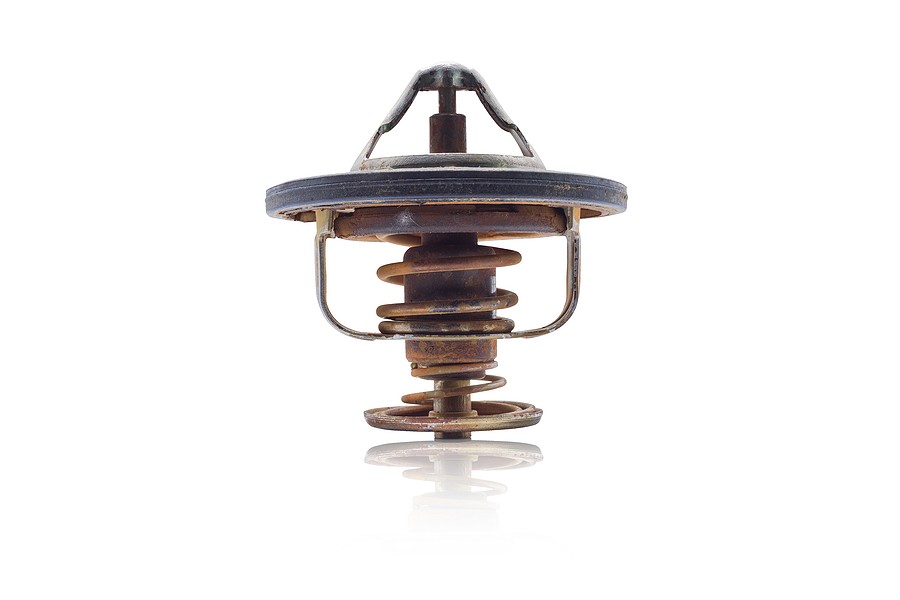If your thermostat is leaking coolant, these are all the potential causes:
- Corrosion
- Gasket failure
- Pressure buildup
The thermostat is a critical component in your cooling system, allowing coolant to pass when the engine temperature exceeds a maximum threshold. T therefore, it's important to maintain a healthy thermostat for your cooling system to operate properly.
When the thermostat goes bad, it leads to all sorts of problems, including preventing engine cooling or the engine from reaching the optimum hot temperature. More importantly, the terms might lead to a coolant leak can be severe.
This article provides everything you need, starting with the causes, symptoms, solutions, and preventions for situations where your thermostat leaks coolant.
What is the thermostat, and how is it connected to the coolant?
Before we dive into the details of situations where your thermostat is leaking coolant, you must understand the main purpose of the thermostat in your cooling system, along with how it's connected to the coolant.
The thermostat is an important gate that allows the colon to pass and run around the engine when the engine temperature exceeds the maximum threshold. The thermostat is designed in a way that senses the engine temperature and prevents the cooling from passing unless it's needed.
With a healthy thermostat, you ensure that your engine will not exceed the maximum temperature. Still, at the same time, it won't allow the coolant to run around the engine. Hence, the engine reaches the minimum temperature and operates properly to generate energy.
A faulty thermostat can lead to many problems, including preventing the engine from cooling down if the thermostat gets stuck closed and reaching the minimum temperature if the thermostat gets stuck closed.
A very critical problem that could happen from a faulty thermostat is when you deal with coolant leaking from the thermostat. This can be very severe and might result in damaging the entire engine.

What are the main causes for thermostat leaking coolant?
Since you need to ensure that your thermostat is healthy and working out all the time and prevent thermostat leaking coolant situations, you need to understand the main causes for this situation from happening in the first place. This way, you can address them immediately and hopefully prevent them.
In general, the list below provides you with the most important causes for thermostats leaking coolant:
1. Corrosion
Over time, the thermostat can deal with common corrosion due to age. When this happens, corrosion allows us to make small cracks within the thermostat that could allow the colon to seep outside the cooling system.
2. Gasket failures
The thermostat housing is sealed using a specific gasket. When this gasket fails over time, it can easily lead to coolant leaking from the thermostat, and therefore, you must maintain the gasket in good shape.
3. Pressure buildup
Finally, the thermostat is expected to receive a specific pressure level. When this pressure level is exceeded, it can easily lead to leaking coolant from the weak seals around the thermostat housing.

What are the main symptoms of thermostat leaking coolant?
As we indicated before, avoiding situations where your thermostat leaves cool is critical because this can damage the entire engine due to overheating. However, not every driver knows the main symptoms of thermostat leaking coolant. Sometimes, they might think it's related to a different component, making the problem more complicated.
The following list provides you with the main important and common symptoms of thermostat leaking coolant:
1. Engine overheating
The first and most common symptom of a general coolant leak, whether related to the thermostat or not, is engine overheating. As mentioned before, the cool is responsible for maintaining the temperature and preventing it from reaching Beyond the maximum allowed point.
When the coolant is leaking from around the thermostat, the coolant levels drop, and this might not allow the engine to cool down because it's not receiving the exact amount of coolant expected.
2. Fluctuating temperature gauge
Since the temperature gauge on the dashboard is responsible for monitoring the engine temperature, it is not surprising to deal with situations where the gauge is reading fluctuating readings when the engine is leaking coolant from around the thermostat.
This is because the engine will be continuously overheating, and the coolant is not enough to reduce the engine's temperature to the optimum level. Therefore, the temperature gauge will reflect this situation and read very high values.
3. Low coolant level
If you look at the coolant reservoir and if the coolant leak from around the thermostat is very severe, you'll see that the coolant level is dropping significantly. This is not a good situation; it can damage the engine in no time if you don't address it.
4. Coolant dripping under the car
Finally, if you visually inspect the thermostat area, you might notice some fluid leaking or dripping underneath the car. Depending on the severity of the leak, the fluid might not be visibly leaking, but it could be a sign of old leaks that dried up because of the hot temperature around the cooling system.
Keep in mind that before you do any visual inspection or touch the system, your vehicle must be cooled down to the point where the cooling system is not very hot and could cause some risks of burns.

How do you diagnose thermostat leaking coolant?
Now you have a general idea about what to look for when your thermostat leaks coolant; the next step is to identify the problem yourself before you even reach your mechanic. This weekend, save time and identify the severity of the problem before you ignore it and decide to go on your day.
The list below provides you with a step-by-step process on what to look for when you suspect that your vehicle has a thermostat leaking coolant:
- Step #1: Choose your parking area in a safe location and park your vehicle
- Step #2: Allow your vehicle to cool down for at least 30 minutes or until the cooling system is cooled down
- Step #3: Identify the location of the thermostat reservoir by referring to your vehicle owner's manual
- Step #4: Look for any potential symptoms of coolant leak around the thermostat housing
- Step #5: Look underneath your car and see if there are any signs of fluid dripping on the floor
- Step# six: Check the reservoir where the coolant is located and see if it's beyond the minimum level
Once you perform this quick inspection, you will know whether your vehicle suffers from a thermostat leaking coolant. If that happens and you confirm that, you need to check with your mechanic as soon as possible before the problem gets very complicated. In some scenarios, you might not be advised to drive this car if the coolant leak is severe.

Thermostat leaking coolant: repairs and preventions
Once your mechanic looks at your coolant level and the vehicle in general, if he confirms that the problem is related to the thermostat, he must address it as soon as possible.
Understanding the problem might be as simple as closing the broken seals or replacing the entire thermostat and housing. Luckily, the entire repair will not be very complicated and will not be as close as to what you'll pay if the problem is related to a bigger component like the radiator.
As you might notice, coolant leak, in general, is not a good thing to deal with, and that's why I remove experts recommend following this advice to prevent dealing with this problem shortly:
- Keep up with regular maintenance
- Inspect the thermostat continuously
- Fix any weak seals that are expected to break
- Never underestimate mine are symptoms of thermostat leaking coolant

Thermostat leaking coolant: Conclusion
Thermostat leaking coolant is a very common situation you might experience during the lifetime of your car. When this happens, it can easily lead to many problems, including damaging the entire vehicle if you leave the problem for a long time.
This article gave you everything you need to know about a situation where your thermostat leaks coolant. Highlighted the main causes comma, symptoms comma, solutions comma, and future preventions.
If you're interested in similar posts, we highly encourage you to visit our blog by clicking here.



